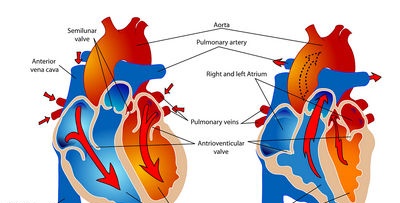|
 Sore throats, being an unsafe disease, often entail complications, often very serious ones, associated with prolonged and sometimes complete disability. Therefore, the issue of prevention and timely and rational treatment of angina is of great social importance. Sore throats, being an unsafe disease, often entail complications, often very serious ones, associated with prolonged and sometimes complete disability. Therefore, the issue of prevention and timely and rational treatment of angina is of great social importance.
The very name "angina" comes from the Latin word "angere", which means to squeeze, crush, choke, similarly, the Russian term "toad" contains the concept of pressing, crushing. Apparently, the main symptom that once attracted the attention of doctors was a constriction of the throat, that is, difficulty in swallowing and even breathing. Especially often, when the disease is severe, there is swelling of the cervical lymph nodes (cervical glands, as they were incorrectly called before), and this further aggravates the picture of "throat constriction".
Earlier, for a long time, angina was considered a local throat disease, since severe painful manifestations are mainly in the throat. Now everyone knows that with angina there is usually an increase in temperature, general fatigue, headache, aching joints, lower back, etc.
All this suggests that this is not only a disease of the throat, but of the whole organism.
So, in essence, a sore throat is called such an acute infectious disease of the body, in which visible local phenomena are expressed mainly in inflammation of the tonsils (tonsillitis), often palatine (yawns).
Where are the palatine (yaw) tonsils located? If you take a mirror, go to the lamp, open your mouth and illuminate it, then we will see teeth, gums and tongue. Further, pressing the tongue with the handle of a teaspoon or tablespoon, you can see a small tongue in the depths. On both sides of it, folds (arches) descend, two on each side. Small almond-shaped formations are visible between these folds on the right and left. The same tonsils are found in the nasopharynx (nasopharyngeal) and at the root of the tongue (lingual).
If local anginal phenomena are most pronounced in the nasopharyngeal tonsil, the term retinosal (retronasal, or nasopharyngeal) angina is used. On the contrary, with inflammation at the root of the tongue, that is, where local phenomena are most pronounced with angina, in this (lingual) tonsil, the term is used - tonsillitis of the lingual tonsil.
The palatine tonsils in their shape, indeed, resemble almonds. They are made up of what is called lymphadenoid tissue, which plays a role in the production of lymphocytes. The palatine tonsil in most cases consists of a number of lobules; they have a number of deep and often branching cracks, which are called lacunas, or crypts (from Latin - "lacuna" - a depression).
 Usually an adult has 15-18 of them in each amygdala. The crypts can accumulate content of one nature or another, which, due to the tortuosity and depth of the crypts, is sometimes not emptied; they get stagnant. About half of the surface of the tonsils is turned into the lumen of the pharynx; it is accessible by examining the pharynx. The opposite surface of the tonsils (invisible on examination) is located deep between the anterior and posterior folds and is covered with connective tissue. Usually an adult has 15-18 of them in each amygdala. The crypts can accumulate content of one nature or another, which, due to the tortuosity and depth of the crypts, is sometimes not emptied; they get stagnant. About half of the surface of the tonsils is turned into the lumen of the pharynx; it is accessible by examining the pharynx. The opposite surface of the tonsils (invisible on examination) is located deep between the anterior and posterior folds and is covered with connective tissue.
Connective tissue spurs, which form the basis of the lobule, extend from it into the thickness of the lobule. Arterial and venous vessels, nerves, which provide communication with the entire human body, pass through the connective tissue.
The size of the palatine tonsils is different. In some healthy people, they are more or less significant, sometimes excessively large. In others, also healthy, they are small, poorly visible or even completely invisible. Previously, it was believed that enlarged ones are necessarily sick, and small ones are normal.Clinical observations carried out in recent years have shown that just the little ones often play a big role in the origin of not only local processes, but also general diseases of the human body. In them, after the development of acute inflammatory or chronic processes, release from the pathological products and bacteria accumulating in the gaps is usually difficult, since they are most often restrained and located deep in the thickness of the surrounding soft tissues. Therefore, special attention must be paid to small tonsils.
Accumulations of lymphoid tissue in the form of lateral, vertically arranged strands or ridges are also found in the thickness of the mucous membrane in the lateral parts of the posterior pharyngeal wall, behind the posterior folds (arches). Their inflammation is called sore throat of the lateral pharyngeal ridges.
It should be noted that in the entire thickness of the mucous membrane of the pharynx there are small accumulations of the same lymphoid tissue "which can sometimes be seen with the naked eye. With inflammation, phenomena similar to those in ordinary angina develop in them; sometimes there are the same raids.
Of all the throat sore throats we have named, the most common diseases are tonsillitis. Therefore, when in medical and common practice they talk about angina without specifying its location and form, they think about this most common angina. We will adhere to this principle in the further presentation.
There is, perhaps, no person among the population who would not have heard of angina, since, indeed, it is very widespread.
Most often they suffer from angina mainly in the flowering age, up to about 35-40 years. Infants are much less likely to suffer from angina. The same should be said for people over 40. and old people rarely have sore throats.
Preobrazhensky B.S. - How to protect yourself from angina and its consequences
The causes of angina
|
 Sore throats, being an unsafe disease, often entail complications, often very serious ones, associated with prolonged and sometimes complete disability. Therefore, the issue of prevention and timely and rational treatment of angina is of great social importance.
Sore throats, being an unsafe disease, often entail complications, often very serious ones, associated with prolonged and sometimes complete disability. Therefore, the issue of prevention and timely and rational treatment of angina is of great social importance. Usually an adult has 15-18 of them in each amygdala. The crypts can accumulate content of one nature or another, which, due to the tortuosity and depth of the crypts, is sometimes not emptied; they get stagnant. About half of the surface of the tonsils is turned into the lumen of the pharynx; it is accessible by examining the pharynx. The opposite surface of the tonsils (invisible on examination) is located deep between the anterior and posterior folds and is covered with connective tissue.
Usually an adult has 15-18 of them in each amygdala. The crypts can accumulate content of one nature or another, which, due to the tortuosity and depth of the crypts, is sometimes not emptied; they get stagnant. About half of the surface of the tonsils is turned into the lumen of the pharynx; it is accessible by examining the pharynx. The opposite surface of the tonsils (invisible on examination) is located deep between the anterior and posterior folds and is covered with connective tissue.








